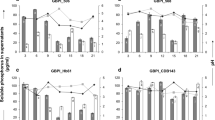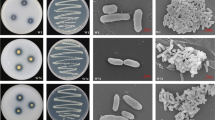Abstract
A study for screening and selection of mutants of Pseudomonas corrugata (NRRL B-30409) based on their phosphate solubilization ability, production of organic acids, and subsequent effect on plant growth at lower temperatures under in vitro and in situ conditions was conducted. Of a total 115 mutants tested, two (PCM-56 and PCM-82) were selected based on their greater phosphate solubilization ability at 21°C in Pikovskaya’s broth. The two mutants were found more efficient than wild-type strain for phosphate solubilization activity across a range of temperature from psychotropic (4°C) to mesophilic (28°C) in aerated GPS medium containing insoluble rock phosphate. High-performance liquid chromatography analysis showed that phosphate solubilization potential of wild-type and mutant strains were mediated by production of organic acids in the culture medium. The two efficient mutants and the wild strain oxidized glucose to gluconic acid and sequentially to 2-ketogluconic acid. Under in vitro conditions at 10°C, the mutants exhibited increased plant growth as compared to wild type, indicating their functionality at lower temperatures. In greenhouse trials using sterilized soil amended with either soluble or rock phosphate, inoculation with mutants showed greater positive effect on all of the growth parameters and soil enzymatic activities. To the best of our knowledge, this is the first report on the development of phosphate solubilizing mutants of psychotropic wild strain of P. corrugata, native to the Indian Himalayan region.


Similar content being viewed by others
References
Allen SE (1974) Chemical analysis of ecological materials. 2nd edn. Oxford: Blackwell Scientific Publications
Das K, Katiyar V, Goel R (2003) ‘P’ solubilization potential of plant growth promoting Pseudomonas mutants at low temperature. Microbiol Res 158:359–362
Dave A, Patel HH (1999) Inorganic phosphate solubilizing soil Pseudomonads. Ind J Microbiol 39:161–164
Gaind S, Gaur AC (1991) Thermotolerant phosphate solubilizing microorganisms and their interaction with mung-bean. Plant Soil 133:141–149
Glick BR, Patten CL, Holguin G, Penrose DM (1999) Biochemical and genetic mechanisms used by plant growth promoting bacteria. 1st edn. London: Imperial College Press
Goldstein AH (1986) Bacterial solubilization of mineral phosphates: historical perspective and future prospects. Am J Alter Agri 1:51–57
Hwangbo H, Park RD, Kim YW, Rim YS, Park KH, Kim TH, Suh JS, Kim KY (2003) 2-Ketogluconic acid production and phosphate solubilization by Enterobacter intermedium. Curr Microbiol 47:87–92
Johri JK, Surange S, Nautiyal CS (1999) Occurrence of salt, pH, and temperature tolerant, phosphatic solubilizing bacteria in alkaline soils. Curr Microbiol 39:89–93
Katiyar V, Goel R (2003) Solubilization of inorganic phosphate and plant growth promotion by cold tolerant mutants of Pseudomonas fluorescens. Microbiol Res 158:163–168
Kucey RMN, Janzen HH, Laggett ME (1989) Microbially mediated increases in plant available phosphorus. Adv Agron 42:199–228
Mishra M, Goel R (1999) Development of cold resistant mutant of plant growth promoting Ps. fluorescens and its functional characterization J Biotechnol 75:71–75
Neijssel OM, Tempest DW, Postma PW, Duine JA, Frank JJ (1983) Glucose metabolism by K+-limited Klebsiella aerogenes: evidence for the involvement of a quinoprotein glucose dehydrogenase. FEMS Microbiol Lett 20:35–39
Pandey A, Palni LMS (1998) Isolation of Pseudomonas corrugata from Sikkim Himalaya. World J Microbiol Biotech 14:411–413
Pandey A, Palni LMS, Mulkalwar P, Nadeem M (2002). Effect of temperature on solubilization of tricalcium phosphate by Pseudomonas corrugata. J Sci Ind Res (India) 61:457–460
Pandey A, Trivedi P, Kumar B, Palni LMS (2006) Characteristics of a phosphate solubilizing and antagonistic strain of Pseudomonas putida (BO) isolated from a sub-alpine location in the Indian central Himalaya. Curr Microbiol 53:102–107
Reyes I, Baziramakenga R, Bernier L, Autoun H (2001) Solubilization of phosphate rocks and minerals by a wild-type strain and two UV-induced mutants of Penicillium rugulosum. Soil Biol Biochem 33:1741–1747
Reyes I, Bernier L, Autoun H (2002) Rock phosphate solubilization and colonization of maize rhizosphere by wild and genetically modified strains of Penicillium rugulosum. Microb Ecol 44:39–48
Richardson AE (2001) Prospects for using soil microorganisms to improve the acquisition of phosphorus by plants. Aust J Plant Physiol 28:897–906
Rodrìguez H, Fraga R, Gonzalez T, Bashan Y (2006) Genetics of phosphate solubilization and its potential applications for improving plant growth-promoting bacteria. Plant Soil 287:15–21
SAS Institute (2003) SAS/STAT guide for personal computers. Cary, NC: SAS Institute
Svitel JJ, Sturdik E (1995) 2-ketogluconic acid production by Acetobacter pasteurianus. Appl Biochem Biotechnol 53:53–63
Tabatabai MA, Bremner JM (1969) Use of p-nitrophenol phosphate for assay of phosphatase activity. Soil Biol Biochem 1:301–307
Tiedje JM, Colwell RK, Grossman YL, Hodson RE, Lenski RE (1989) The planned introduction of genetically engineered organisms: ecological considerations and recommendations. Ecol 70:298–315
Trivedi P, Kumar B, Pandey A, Palni LMS (2007) Growth promotion of rice by phosphate solubilizing bioinoculants in a Himalayan location. In: Velázquez E, Rodríquez-Barrueco C (eds) First international meeting on microbial phosphate solubilization, vol 1. Dordrecht, Springer, pp 291–299
Trivedi P, Pandey A, Palni LMS (2007) In vitro evaluation of antagonistic properties of Pseudomonas corrugata. Microbiol Res (in press)
Vazquez P, Holguin G, Puente ME, Lopez-Cortes A, Bashan Y (2000) Phosphate-solubilizing microorganisms associated with the rhizosphere of mangroves in a semi arid coastal lagoon. Biol Fertil Soils 30:460–468
Acknowledgments
The Senior author (P.T.) gratefully acknowledges financial support from the Department of Science and Technology (DST), Government of India, in the form of a Young Scientist award under the SERC FAST TRACK Scheme.
Author information
Authors and Affiliations
Corresponding author
Rights and permissions
About this article
Cite this article
Trivedi, P., Sa, T. Pseudomonas corrugata (NRRL B-30409) Mutants Increased Phosphate Solubilization, Organic Acid Production, and Plant Growth at Lower Temperatures. Curr Microbiol 56, 140–144 (2008). https://doi.org/10.1007/s00284-007-9058-8
Received:
Accepted:
Published:
Issue Date:
DOI: https://doi.org/10.1007/s00284-007-9058-8




